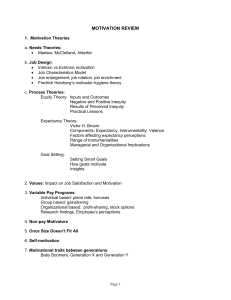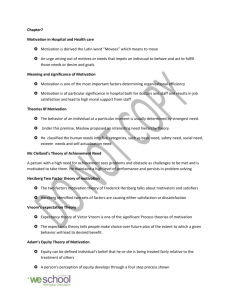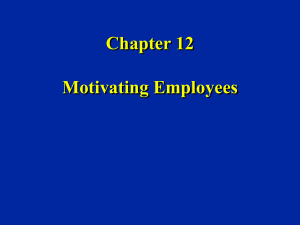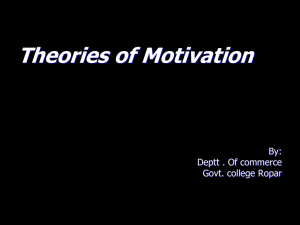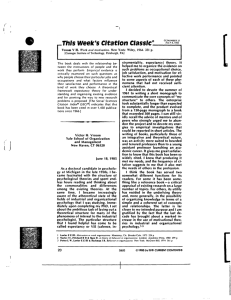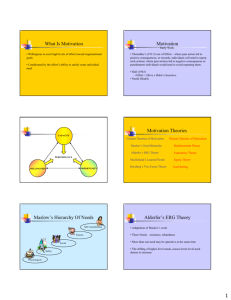Chapter 7 Motivating & Leading Technical People
advertisement
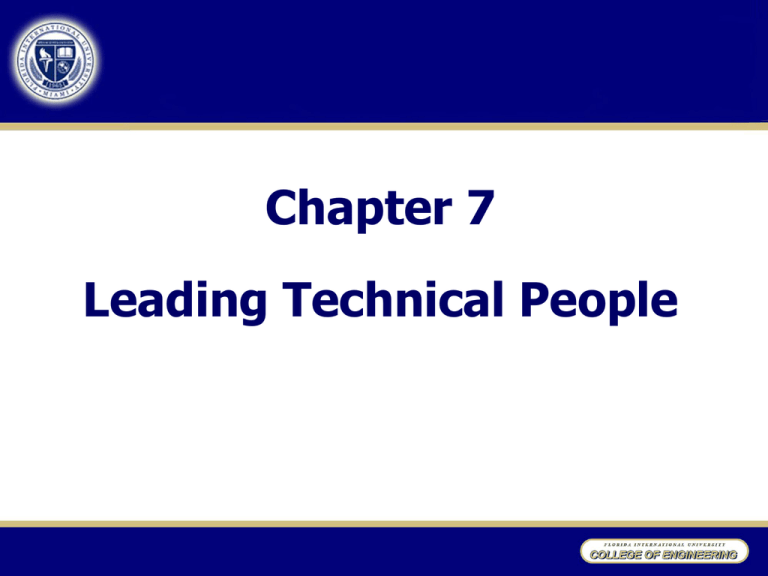
Chapter 7 Leading Technical People Advanced Organizer Managing Engineering and Technology Management Functions Planning Decision Making Organizing Leading Controlling Managing Technology Personal Technology Research Time Management Design Ethics Production Career Quality Marketing Project Management Chapter Objectives • Explain the difference between leaders and managers • Describe the nature of leadership and its significance to an organization • Address the application of servant leadership in current organizations • Recognize the different views of motivation Leadership & Management Management Function Formal & rational methods Experienced Leadership Relationship Passion & emotion --Michael Maccoby Leadership & Management Managers Administer Ask how and when Focus on systems Do things right Maintain Short term perspective Imitate Are a copy Leaders Innovate Ask what and why Focus on people Do the right things Develop Longer term perspective Originate Are original --Warren Bennis Nature of Leadership Leadership is the process of getting the cooperation of others in accomplishing a desired goal. “mixture of persuasion, compulsion, and example that makes men do what you want them to do.” --Sir William Slim, commander of the British Army “You know what makes leadership? It is the ability to get men to do what they don't want to do and like it.” --Harry Truman Types of Leaders • Formal leaders are appointed branch manager or committee chair or team captain and have the advantage of formal authority (including the power to reward and punish), but this only gives them the opportunity to prove themselves effective at leadership. • Emergent, or informal leaders evolve based on their expertise or referent power as it is expressed in the process of group activity. Identifying Potential Leaders • Leadership Traits • Myers-Briggs Type Indicator (MBTI) Leadership Traits • Physical qualities of health, vitality, and endurance; • Personal attributes of personal magnetism, cooperativeness, enthusiasm, ability to inspire, persuasiveness, forcefulness, and tact; • Character attributes of integrity, humanism, self-discipline, stability, and industry; and • Intellectual qualities of mental capacity, ability to teach others, and a scientific approach to problems. Myers-Briggs Type Indicator (MBTI) 1. The most favored Energy Source: – The way people prefer to interact with the world, and the way they prefer to receive stimulation and energy. (E) Extraversion <> (I) Introversion 2. The most favored Perceiving Mental Process: – The way people prefer to get data. (S) Sensing <> (N) Intuition 3. The favored Judging Mental Process: – The way people prefer to make decisions (T) Thinking <> (F) Feeling 4. The mental process leads to Outside World Orientation: – The way people prefer to orient their lives (J) Judging <> (P) Perceiving Classification of Leadership Style I. People/Task Matrix Approaches • The Leadership Grid • Ohio State studies • Hersey and Blanchard life-cycle theory II. Situational Approaches • Leadership continuum • Other viewpoints People/Task Matrix approaches The Leadership Grid Concern for People (1,9) Country Club Management (9,9) Team Management, in which individual objectives are achieved in the process of achieving organizational goals, (5,5) Middle of the Road Management (1,1) Impoverished Management (9,1) Authority Compliance Management Concern for Production Ohio State studies Initiating Structure (IS) High Low Consideration (C) Low High H(IS)/L(C) L(IS)/L(C) H(IS)/H(C) L(IS)/H(C) Findings: •High IS – High C may not be the most effective •High IS helps only if task is unstructured. •High C helps only if there is no adequate alt. source of satisfaction Hersey and Blanchard life-cycle theory (or "maturity" theory) "the most effective leadership progresses with time through the four quadrants” High Initiating Structure, Low Consideration High Initiating Structure, High Consideration Low Initiating Structure, High Consideration Low Initiating Structure, Low Consideration Situational Approaches Contingency theory The manager must develop a reward system, a leadership style, or an organizational structure to be appropriate for the unique combination of such factors as • the nature of the subordinates, • the technology of the business and the tasks that result, • the rate of change in the organization, • the degree of integration of functions required, • the amount of time the manager has to accomplish the assignment, • the quality of the manager's relationship with subordinates. Leadership Continuum "a continuum of leadership style extending from complete • • • • retention of power by the manager to complete freedom for subordinates" Autocratic ("Telling"). Manager makes decisions with little or no involvement of non-managers. Diplomatic ("Selling). Manager makes decisions without consultation but tries to persuade non-managers to accept them. Consultative ("Consulting"). Manager obtains nonmanagers' ideas and uses them in decision making. Participative ("Joining"). Manager involves nonmanagers heavily in the decision (and may even delegate it to them completely). Leadership continuum (cont.) 3 • • • deciding forces: Forces in the manager Forces in the subordinate (or non-manager). Forces in the situation. Servant Leadership • Practical philosophy which supports people who choose to serve first, • Then lead as a way of expanding service to individuals and institutions. Other viewpoints: 14 types of executives by their behavior "merely successful" (Table 7-3) • Bureaucrat • Zealot • Machiavellian • Missionary • Climber • Exploiter • Temporizer • Glad-Hander Other viewpoints: 14 types of executives by their behavior "effective leaders" (Table 7-4) • Entrepreneur • Corporateur • Developer • Craftsman • Integrator • Gamesman True Leader "A leader is best when people barely know he exists. Not so good when people obey and acclaim him. Worse when they despise him. But of a good leader who talks little, when his work is done and his aim fulfilled, they will say, "We did it ourselves." -- Lao Tsu, 600 B.C. Motive & Motivation Definition of Motive: • “An inner state that energizes, activates, or moves, and that directs or channels behavior toward goals.” – Berelson & Steiner Definition of Motivation: • “The willingness to exert high levels of effort to reach organizational goals, conditioned by the effort’s ability to satisfy some individual need.” – Robbins • “3 measures of resulting behavior: direction, strength, and persistence” – Campbell Nature of the Individuals • McGregor's Theory X and Theory Y (2 assumptions about basic nature) Nature of the Individuals "Theory X": • Management is responsible for organizing the elements of productive enterprise--money, materials, equipment, people-in the interest of economic ends. • With respect to people, this is a process of directing their efforts, motivating them, controlling their actions, modifying their behavior to fit the needs of the organization. • Without this active intervention by management, people would be passive--even resistant to organization needs. They must therefore be persuaded, rewarded, punished, controlled--their activities must be directed. This is management's task.... Nature of the Individuals Additional beliefs of "Theory X": • The average person is by nature indolent—he/she works as little as possible. • He/She lacks ambition, dislikes responsibility, prefers to be led. • He/She is inherently self-centered, indifferent to organizational needs. • He/She is by nature resistant to change. • He/She is gullible, not very bright, the ready dupe of the charlatan and the demagogue. "Theory Y" • Management is responsible for organizing the elements of productive enterprise--money, materials, equipment, people--in the interest of economic ends. • People are not by nature passive or resistant to organizational needs. They have become so as a result of experience in organizations. "Theory Y" • The motivation, the potential for development, the capacity for assuming responsibility, the readiness to direct behavior toward organization goals are all present in people. Management does not have to put them there. It is the responsibility of management to make it possible for people to recognize and develop these human characteristics for themselves. • The essential task of management is to arrange organizational conditions and methods of operation so that people can achieve their own goals best by directing their own efforts toward organizational objectives. “Theory X” v.s. “Theory Y” “Theory X places exclusive reliance upon external control of human behavior, while Theory Y relies heavily on self-control and self-direction. It is worth noting that this difference between treating people as children and treating them as adults.” --McGregor Motivation Theories: Content Theories: Based on human needs and people’s effort to satisfy them • Maslow's hierarchy of needs • Herzberg's 2-factor theory • McClelland’s Trio of Needs Process Theories: Assumes that behavioral choices are based on expected outcomes • Equity Theory (Adams) • Expectancy Theory (Vroom) • Porter-Lawler Extension • Behavior Modification (Skinner) Maslow's hierarchy of needs. (The appearance of one need usually rests upon the prior satisfaction of another.) • Physiological needs: air, water, food, shelter, sex • Safety needs: safe work, with security that the physiological needs will continue to be met (through job tenure and medical, unemployment, and disability insurance and retirement provisions) • Love needs: affectionate relations with friends, family, and people in general, and group acceptance • Esteem needs: self-respect or self-esteem, and the esteem of others (expressed in reputation, prestige, and recognition) • Self-actualization (or self-fulfillment) needs: the desire to become everything one is capable of becoming (to become actualized in what one is potentially) Herzberg's 2-factor Theory • The growth or motivator factors that are intrinsic to the job are [in order of decreasing importance]: achievement, recognition for achievement, the work itself, responsibility, and growth or advancement. • The dissatisfaction-avoidance or hygiene factors that are extrinsic to the job include [also in order of decreasing importance]: company policy and administration, supervision, interpersonal relationships, working conditions, salary, status, and security. Applications of Herzberg's 2-factor Theory • Job Enrichment: To increase the content of motivators in a job. • Reducing the number and frequency of controls • Making the worker responsible for checking his/her own work • Establishing a direct relationship between worker and the customer (internal or external) • Increasing authority and autonomy McClelland’s Trio of Needs (Different people have different needs) • Need for achievement: the drive or desire to excel, to accomplish something better than has been done in the past. (entrepreneurs) • Need for power: the desire to control one’s environment, including resources and people. (managers) • Need for affiliation: the need for human companionship and acceptance. (coordinators, integrators, counselors, and sales) Process Theories: Process theories treat human needs as just one part of the mechanism that people use in choosing their behavior. These theories place greater emphasis on the expectation of favorable consequences or rewards. A. Equity Theory “People want to be treated fairly relative to the treatment of others.” Input/outcome ratio: • Inputs: person’s contribution to the organization (education, experience, ability, effort, and loyalty) • Outcomes: pay, promotion, recognition, and social relationships B. Expectancy Theory Environment Effort Performance Outcome Ability Effort to Performance Expectancy Performance to Outcome Expectancy Valence of Outcomes B. Expectancy Theory • Effort-to-performance expectancy • Performance-to-outcome expectancy • Valence: Strength of a person’s desire for these outcomes C. Porter-Lawler Extension • Personal effort, abilities and traits, and role perceptions (the employee's belief that certain tasks need to be done to do his or her job effectively) determine performance. • Performance, in turn, leads to intrinsic and extrinsic rewards, as in the expectancy model. • The perceived equity (fairness) of these rewards determines the satisfaction the employee gains from the work. • This satisfaction colors the value placed on the rewards anticipated for future cycles of work, and therefore it influences future effort. D. Behavior Modification (Reinforcement Theory) Behavior is followed by an event (reinforcement) that affects the probability that the behavior is repeated. • Positive reinforcement increases the probability that desired behavior will be repeated by providing a reward (praise, recognition, raise, promotion, or other). • Negative reinforcement, or avoidance, seeks to increase the probability that desired behavior will be repeated by letting the employee escape from undesired consequences. • Punishment seeks to decrease the probability that undesired behavior will be repeated by imposing penalties (undesired consequences) such as reprimands, discipline, or fines. • Extinction seeks to decrease the probability that undesired behavior will be repeated by ignoring it and withholding positive reinforcement. Motivating And Leading Technical Professionals General Nature of the Technical Professional • Having a high need for achievement and deriving their motivation primarily from the work itself. • Desiring autonomy (independence) over the conditions, pace, and content of their work. • Tending to identify first with their profession and secondarily with their company. • Seeking to maintain their expertise, gained through long and arduous study, and stave off obsolescence through continuing education. Motivation Factors for Engineers 1. 2. 3. 4. 5. Type of work, interesting, diversified (45.0%) Salary (33.9%) Location, good place to live, family (31.2%) Opportunity for advancement (29.8%) Challenge, more responsibility, chance to use creative ability (16.9%) 6. Reputation, prestige of company (13.7%) 7. Working conditions, personnel policies (11.7%) 8. Growing organization, growing field (6.9%) 9. Security, retirement plan, benefits (6.8%) 10. Opportunity to learn, broaden experience, training programs (6.6%) Leading Technical Professionals Dimensions of technical leadership • Coach for peak performance • Run organizational interference • Orchestrate professional development • Expand individual productivity through teamwork • Facilitate self-management Leading Technical Professionals Leading as orchestration -- McCall • Technical competence. • Controlled freedom. • Leader as metronome. • Work challenge.
